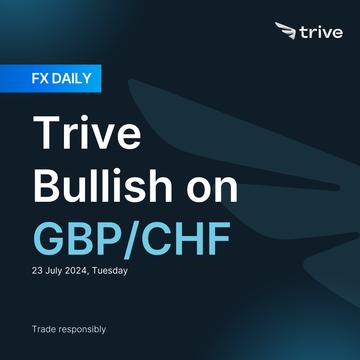Weekly Market Outlook (22 July - 26 July 2024)

This week's market focus will be on US PCE with other highlights including the BoC rate decision and MPR, the PBoC LPR, and PMI data and CPI from Tokyo.
- PBOC LPR (MONDAY)
The PBoC is expected to maintain its benchmark Loan Prime Rates next week with the 1-year and 5-year LPR to be kept at the current levels of 3.45% and 3.95%, respectively. The likelihood for China to maintain its benchmark rates follows the central bank’s decision to keep its 1-year Medium-term Lending Facility rate at 2.50% as this serves as a fairly accurate leading signal for the intentions regarding the LPRs which are the rates that most new loans and mortgages are referenced on. The central bank is also seen to be focusing on short-term liquidity measures which were evident in the increased injections during this week’s 7-day reverse repos announcements, while it was reported earlier this month that it would conduct temporary overnight repos or reverse repos based on market conditions to keep banking system liquidity reasonably ample and to increase the accuracy and efficiency of open market operations.
Furthermore, industry sources cited by PBoC-backed Financial News stated that the PBoC will make clear it will start to use a short-term interest rate as its main policy rate after reducing the importance of the MLF rate as a policy benchmark which suggests a lack of urgency to adjust the benchmark LPRs. Nonetheless, future rate adjustments cannot be ruled out given recent data releases including a contraction in imports, as well as softer-than-expected CPI and Retail Sales data which suggest weak domestic demand, while GDP data for Q2 also missed estimates and House Prices have continued to contract. As such, if the data continues to deteriorate, it could stoke slowdown concerns and warrant support measures, while analysts cited by Shanghai Securities News recently noted that China may see a window to cut its interest rates or RRR at the end of Q3 or in Q4 to support its economy.
- Eurozone FLASH PMI (WEDNESDAY)
Expectations are for manufacturing PMI to tick higher to 46.0 from 45.8, and services to rise to 53.0 from 52.8, leaving the composite at 50.8 vs. prev. 50.9. As a reminder, the prior release saw the manufacturing print fall to 45.8 from 47.3, and services declined to 52.8 from 53.2, leaving the composite at 50.9 vs. prev. 52.2. The accompanying report noted, “While the manufacturing sector weakened considerably in June, activity growth in the services sector continued to be nearly as robust as the month before." This time around, attention will in part be on whether any of the political uncertainty has filtered its way into the data and to what extent.
Furthermore, given the more cautious stance of the ECB on price pressures in the Eurozone, cost metrics in the release will likely get extra attention. From a policy perspective, with the ECB’s July meeting only just in the rearview mirror and a lot of data between now and the September meeting, the release will likely not have too much sway on market pricing. Inflationary developments and comments from ECB officials will act as more of a guiding force for that meeting which currently assigns a circa 64% chance of a cut.
- UK FLASH PMI (WEDNESDAY)
Expectations are for the services print to nudge higher to 52.5 from 52.1, and manufacturing to rise to 51.2 from 50.9, leaving the composite at 52.6 vs. prev. 52.3. As a reminder, the prior release saw the services print decline to 52.1 from 52.9, andmanufacturing slip to 50.9 from 51.2, leaving the composite at 52.3 vs. prev. 53.0. The accompanying report noted that the UK is “on track for another quarter of GDP growth…albeit one that will be less punchy than the first quarter's 0.7%." This time around, analysts at Investec note that the certainty provided by the outcome of the General Election and the “new government’s key focus on strengthening growth, should help companies to firm up their own plans for the future”. As such, the desk expects a bounce for both the services and manufacturing components.
On prices, Investec notes “in June, despite some easing in input cost pressures, the prices charged index moved up. A reversal of this would be very welcome from the MPC’s perspective”. From a policy perspective, the release will be the main data highlight before the August BoE announcement, which is a near-enough coin flip. The release may cause some move in market pricing on the day, however, it is unlikely to seal the deal one way or the other given the MPC’s fixation on services inflation and real wage growth.
- BOC ANNOUNCEMENT (WEDNESDAY)
The current analyst poll has not been released yet, but money markets currently assign an 80% probability of a rate cut in July after soft data while ING, RBC, and Scotia all look for the BoC to follow up with another 25bp rate cut after cutting by25bp in June. Recent data has been on the cool side, inflation continued to ease with the average of the BoC core measures rising 2.6% Y/Yin June, down marginally from the prior 2.63%, albeit this was revised down from 2.70%.
Meanwhile, the June jobs report was soft with the unemployment rate ticking up to 6.4% from 6.2%, above the 6.3% forecast. The monthly employment change was also disappointing, falling by 1.4k, with a decline of 3.4k full-time jobs, and a gain of 1.9k part-time jobs, well beneath the expected 22.5k and prior 26.7k. The latest business outlook survey saw that most respondents expect inflation to return close to target in 2-3 years, while outlooks were mostly unchanged from the prior quarter, remaining more pessimistic than average.
The share of firms reporting labour shortages is at near survey lows, but only a few firms plan to reduce headcounts. On prices, firms expect the growth of their input prices and selling prices to slow, suggesting that inflation will continue to decline over the coming year. A soft labour market and more signs of cooling price pressures ahead open up the door for another rate cut in July. Looking ahead, markets are fully pricing in two 25bp rate cuts this year, with a 60% probability of a third.
The focus of this meeting will be on the rate decision, but any guidance on rates in the statement will also be key. This meeting will also be accompanied by the latest Monetary Policy Report, which will also be used to gauge how the BoC expects the economy to perform, which may provide insight into their future easing process. ING is of the view that the BoC cut rates again in July, and expects a further 50bp of rate cuts thereafter. The desk acknowledges the rise in the unemployment rate and sub-forecast inflation led the bank to shift its view to expect a rate cut at the upcoming meeting.
- US GDP ADVANCE (THURSDAY)
The US advance Q2 GDP report will be released on Thursday, July 25th. The Final Q1 print saw growth at 1.4%, while Q2 growth is currently tracking at 2.7%, according to the Atlanta Fed GDPNow estimate, albeit this will be updated on Wednesday, July 24th. Over Q2, retail sales data saw the April report revised lower to -0.2%, falling from March's 0.6%, whilst May saw a 0.1% gain, and June was unchanged, although above the -0.3% forecast. Nonetheless, the control metric, which is a strong gauge of consumer spending, declined 0.5% in April, rose 0.4% in May, and surged 0.9% in June, suggesting the consumers were spending more in the latter parts of the quarter.
Within the durable goods reports, it is the nondefense capital goods ex-aircraft shipments that are incorporated into the GDP report, and that saw a 0.4% rise from March to April, but a 0.5% decline from April to May; with the nominal Dollar amount of shipments in the latest report only marginally beneath the March number. The current consensus for GDP is for 1.8% growth in Q2, but analyst forecasts are varied, ranging between 1.2-2.6%. The consensus will likely adjust closer to the data as more submit their forecasts.ING are towards the top end of forecasts, pencilling in 2.5% to reflect better consumer spending, rising inventories and slightly stronger investment readings. Looking ahead, they expect weaker growth in H2 with the Fed to start cutting from September.
- JAPANESE TOKYO CPI (FRIDAY)
Tokyo Core CPI for July is expected to tick up to 2.2% from 2.1% in June; Tokyo inflation data is seen as aleading indicator of the national price trend. The data will also come a week before the BoJ meeting. Analysts at ING “expect Tokyo coreinflation to rise 2.0% YoY, which is above the BoJ’s target of 2%”. The desk also posits that “Together with strong wage growth, a recovery inthe auto sector, and retail sales, the BoJ is expected to deliver a 15bp hike at its July meeting.”
- US PCE (FRIDAY)
US PCE for June, the Fed's preferred gauge of inflation, is due on July 26th whereby current analyst forecasts for core PCEM/M are ranging between 0.15-0.2%. Moreover, ING notes that the core PCE deflator is expected at 0.2% M/M, with risks skewed toward the downside. The bank adds that the core CPI print was just 0.1% M/M, but some of the PPI inputs into the PCE deflator, such as portfolio fees and transport, favour 0.2%. Even so, this would be tracking at the run rate required to deliver 2% Y/Y inflation over time and should keep those interest rate cut expectations in place.
In June, US CPI was cooler-than-expected across the board highlighted by Core M/M rising only 0.1% (exp. & prev. 0.2%), while the Y/Y pace eased to 3.3% (prev. & exp. 3.4%). The headline came in beneath all analyst forecasts at -0.1% (exp. +0.1%, prev. 0.0%), with the Y/Y easing to 3.0% (prev. 3.3%), beneath the 3.1% forecast. The June PPI was hot, but there were chunky revisions to May’s numbers and analysts at Bank of America noted that overall, the components of the PPI report that affect the report, were softer. Following the inflation metrics, WSJ’s Fed watcher Nick Timiraos said that based on the June CPI and PPI, forecasters who map out the PCE expect core prices to rise 0.17% in June, which would hold the 12-month rate at 2.6%.
Moreover, the six-month annualized rate would tick up to 3.3% and the three-month annualized rate would fall to 2.1%. However, Pantheon Macroeconomics notes that"The core PCE print can’t be predicted perfectly, as the BEA uses expert judgement in the seasonal adjustment of some components, and some series are derived from non-CPI/PPI data sources that are unavailable prior to publication".
Lastly, Fed's Waller noted the recent inflation data makes him more confident that the Fed will achieve its inflation goal, but on monthly PCE inflation, he needs to see a bit more evidence that this will be sustained, which is in fitting with recent commentary seen from other officials. Money markets are currently fully pricing in the first cut by September, with 62.5bps priced in by year-end (implying two or three 25bp rate cuts for 2024), with a near zero percent chance at the next meeting on July 31st.
Disclaimer: This material is provided for informational purposes only and does not constitute financial, investment or other advice. No opinion contained in this material constitutes a recommendation by Trive International or its author as to any particular investment, transaction or investment strategy and should not be relied upon in making any investment decision. In particular, the information does not consider the individual investment objectives or financial circumstances of the individual investor Trive International shall not be liable for any loss, damage or injury arising from the use of this information. Trive International may or may not be able to provide equity in the companies. The value of your investment may go down as well as up.
For more information about Trive International, please visit http://trive.com/int
No comments
Home
Trive
TriveHub





0 comments